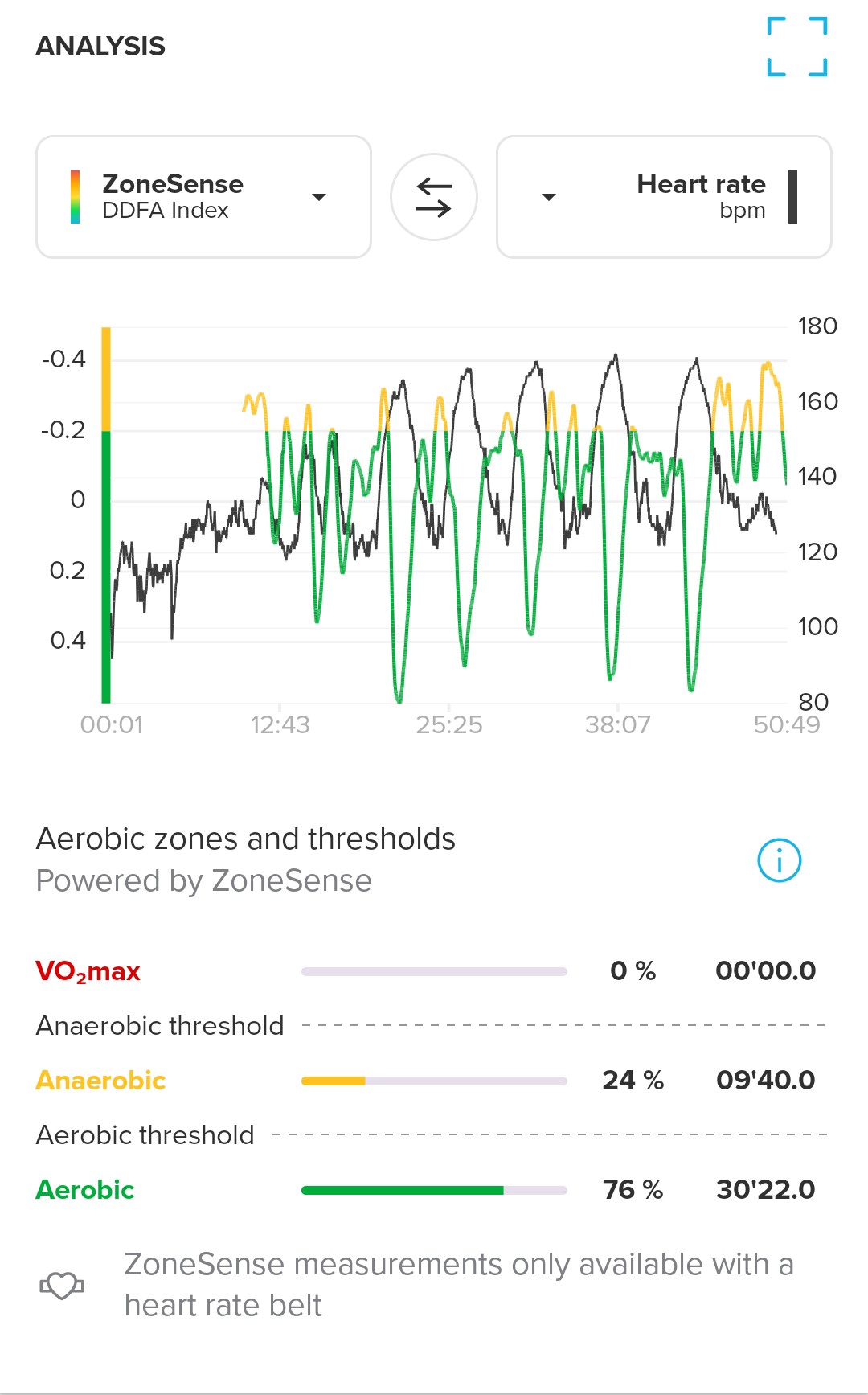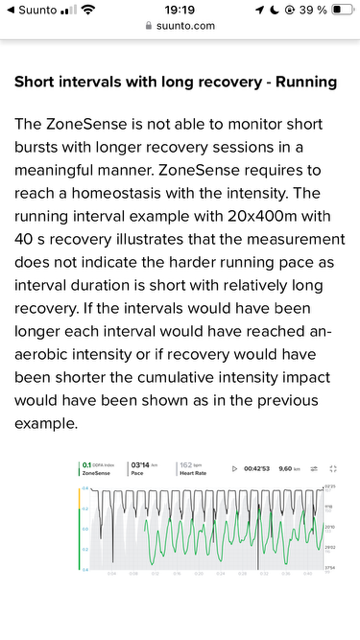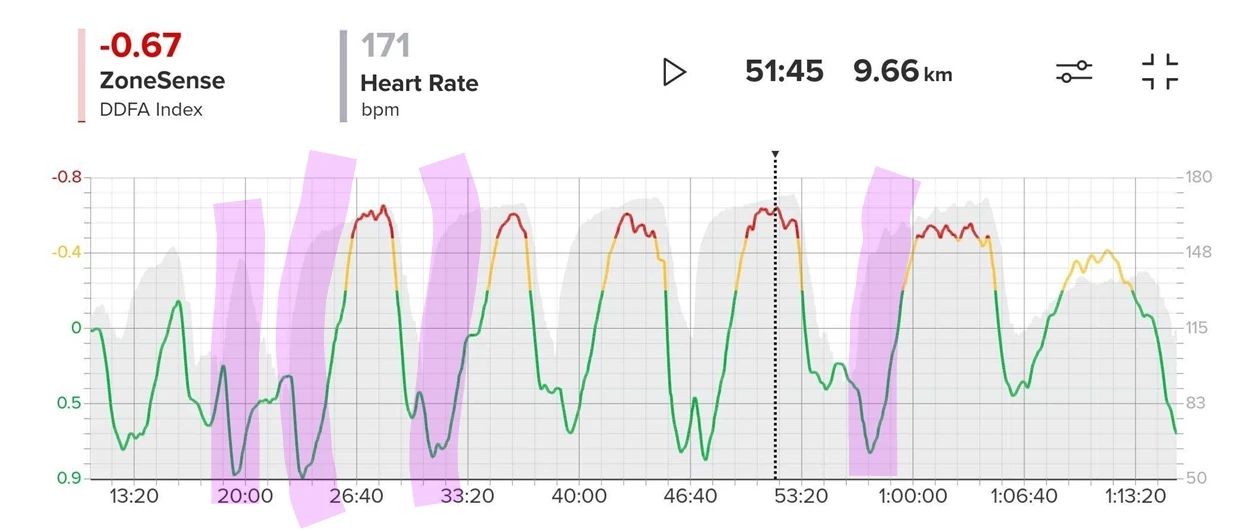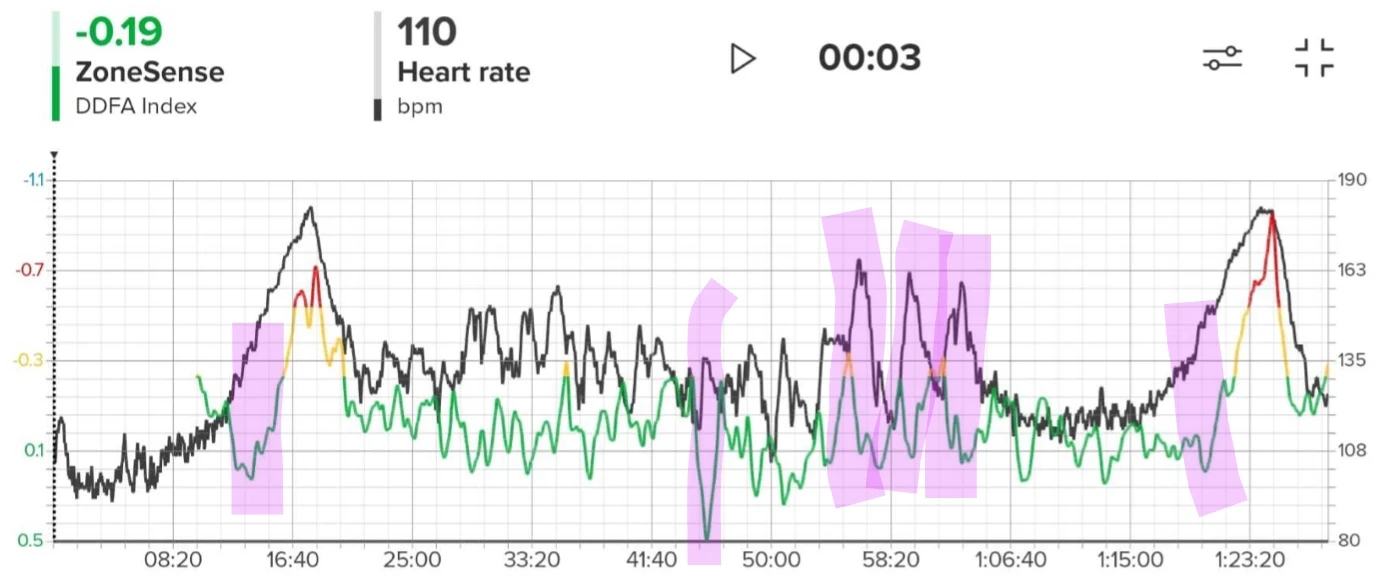Suunto ZoneSense
-
@Mff73 you need a chest strap that measures R-R and the S+ app is my understanding.
-
@larrybbaker for real time, yes. For seeing ZoneSense in the app, just the strap is enough.
-
Hello,
So I will give my point of view of ZoneSense.
I’ve had a Race S for a little over a week. When I read that Suunto was coming out ZoneSense, I said to myself “oh that’s not bad!”.
Today, I decided to test this on a road bike ride, on a course that I know perfectly, to see how it works.
I just got back from the exit and my first reaction is…a communication shot from Suunto to make people wait for functions that are slow to arrive on their watch.
I did 39kms in 01h37.
I regularly looked at the watch while driving. The ZoneSense screen showed me 01:23 in Aerobic and the rest in Anaerobic.
I drove hard over 5kms, average speed of 39km/h, heart rate between 160 and 170… The watch told me in Aerobics!?
Once synchronized, the application gives me 0h55 in Aerobic, 0h23 in Anaerobic, and 0h08 in VO2 Max.
It’s nice but it’s by doing the exercise that you have to see that, not after.
So maybe the function needs to be refined, but I’m sorry, I’m a user, not a tester.
The function does not allow you to train at all by aiming at “real-time” areas as Suunto says.
In short disappointed.
-
This is interesting. How much time has to pass in order for the algorithm to catch the change? I’ve observed something counter intuitive:
- the arrow was as low as possible when cycling at about 120 HR
- the arrow started rising when I stopped and had a quick rest with HR below 90
This is what I saw with S+
The estimation in SA is similar to last workout - 121vs 123 HR.
-
Indeed, the arrow remains at the bottom if the heart rate is low, around 120.
After warming up, I took a slope at a good pace, for 4 minutes. The arrow is mounted slowly to arrive in Anaerobic towards the end of the slope.
So I told myself that it worked and that the effort had to be prolonged for the areas to change.
Except that the 5kms period, where I drove hard (heart rate between 160 and 170), the arrow had to stay at half of the green zone. And in the application this corresponds to a part in Anaerobic then in VO2 Max.
In any case, aerobics corresponds to a not too intense effort. And given the exit I made, this does not correspond at all to the data indicated by the watch.
Even the data indicated in the application is limited.
My feeling would be rather in the 40 minutes of aerobics instead of the 55 indicated.
35 in Anaerobic instead of 23.
And the VO2 Max must roughly correspond on the other hand.
-
Can’t understand it, it’s totally counter intuitive.
ZoneSense rises when I rest and falls when I am in a 2 minute interval.
Polar H10 used.

-
@mlakis
I also use a Polar, but my zones match with ZoneSense.For you indeed it’s completely wrong.
-
@mlakis read again the manual. It cannot be used for such short intervals.

-
@Egika thanks for the explanation, this makes sense.
-
Not tested yet but very interesting feature.
I have taken a look to older activites where I was using chest strap.
Despite suunto says it may not be very relevant on older activities, I’ve found that it pretty correlated to my HR zones, for trail running and running activities. IT seems that My HR zones for running are pretty well set.
What was more interesting to me is that for bike rides, zonesense seems clother to the feelings i had. much clother than what HR mesurement was suppose to tell. -
Ok, from what I understand there are certain scenarios where the ZoneSense does not work.
After a quick read, I understand that what ZoneSense does is that it can detect and represent the “real” kind of an effort (aerobic, anaerobic, VO2) especially when due to cumulative stress, the effort may be more taxing than what is represented by the heart rate.
But I think it’s overwhelming when exercising or even after training to sit and “study” the graphs for each situation and conclude if ZoneSense makes sense or not for it.
-
-
@mlakis You do not have to study the graphs and see if they make sense. The manuscripts published in peer reviewed sports journals on DDFA have already done this with significant cohorts of individuals. Suunto did not invent this but collaborated to be the first to bring to a watch. If you are fixed on HR zones for training we know that HR is inadequate for ultramarathons and for very short intervals (1 min or less). The advantage of ZoneSense is real time effort. For example, when testing and training I did three ≥4300m peaks on successive days for trail runs. Obviously on the final day I was fatigued. ZoneSense showed that accurately in real time. When I go back and look at the information my Aerobic HR on the first day at 144 bpm had dropped to 122 bpm on the third day! Depending on what you are training for, this would allow you to immediately determine the same effort on day 1 and day 3 would affect training load differently with much more stress on day 3. If I want to keep my effort levels event and not raise them ZoneSense allows me to reduce my effort on day 3 so I do not train too hard.
This is revolutionary and for me eliminates the need to be checking HR on my efforts! During long training runs and races I can use ZoneSense to ensure I stay within the effort I should as I gain fatigue. When exercising all I have to do see the zone I am in. For example, I have a half marathon trail race coming up on Sunday, the shortest race I have ever attempted. I am going to use ZoneSense to see if I can maintain my entire effort in the low anaerobic zone the entire race.
-
@Brad_Olwin, thanks for the analysis.
I mainly cycle in varying terrain where even “steady efforts” are not steady enough on the HR perspective.
I had a look on my previous trainings and the trend where the ZoneSense metric makes a deep when HR raises is very often.
I guess it does not work well with the way I train.
-
I’m still not seeing ZoneSense in the Suunto phone app on any of my activities using a heart rate chest strap. I’m using version 2.38.0 (16480) on iOS (the latest beta version available through TestFlight). My heart rate monitor is a Wahoo TICKR. I’ve looked at activities recorded using my Spartan and others recorded with other devices and synced to the Suunto App.
When I look at the Analysis chart in the activity card, I don’t have the option to select ZoneSense as a chart variable.
Am I missing something? With activities recorded on non-Suunto devices and synced to the Suunto App, the activity card doesn’t show time in heart rate zones, because the zones are defined on the watch. But my impression was that ZoneSense was done in the phone app (or in the cloud), since it supposedly works for activities recorded with older Suunto watches too. Either way, I’m not seeing anything even for activities recorded on my Spartan.
-
How long should I stay in above anaerobic threshold in order to get a post-workout anaerobic threshold estimate? On average.
-
And this deep/“dive” on the metric is evident generally when the HR starts to ramp up, even in the examples given by Suunto:


Excuse me for the sketchy way I marked them, I am using my phone to do it.
-
@Brad_Olwin thanks for the write-up and I appreciate your understanding of this as you are a scientist yourself.
I’m curious about this and listened to the video lectures by Suunto. Am I correct in understanding it this way that when I’m focused on base building in max 1-1.5 hr workouts, I can safely push within what Zonesense lays out for me as my Aerobic Zone (AeZ). So even though I may occasionally dig into my previous Z3, in this new paradigm (and how it’s co-related to lactic acid levels and actual stress), I am still effectively able to work on my base building without affecting my progress.
As an amateur, when it comes to the science here, I took as gospel the philosophy Steve House and Scott Johnston pitched and the strict emphasis to not touch Z3. I think some of my thoughts are just fragments of that old paradigm and the old tools that I’m trying to unlearn.
I’ve had one run on this so far and honestly I didn’t even look at the watch after the initial 5min of data from Zonesense, I just ran with my feeling of what felt like an appropriate effort and the results aligned with how I was feeling. So I’m definitely convinced here.
-
@Brad_Olwin said in Suunto ZoneSense:
During long training runs and races I can use ZoneSense to ensure I stay within the effort
This is one problem I have with the implementation. Longer runs and efforts are when I ditch the HR belt in favor of either an optical arm band or the watch’s OHR. I’d imagine this is true for most endurance athletes, at least come race day, as having the chest strap on for multiple hours is chafe-city.
I’m quite intrigued by ZoneSense, but a little bummed that I’ll need to strap on the chest monitor to get the benefits. I understand why it’s necessary, though.
-
@Brad_Olwin said in Suunto ZoneSense:
@mlakis You do not have to study the graphs and see if they make sense. The manuscripts published in peer reviewed sports journals on DDFA have already done this with significant cohorts of individuals. Suunto did not invent this but collaborated to be the first to bring to a watch. If you are fixed on HR zones for training we know that HR is inadequate for ultramarathons and for very short intervals (1 min or less). The advantage of ZoneSense is real time effort. For example, when testing and training I did three ≥4300m peaks on successive days for trail runs. Obviously on the final day I was fatigued. ZoneSense showed that accurately in real time. When I go back and look at the information my Aerobic HR on the first day at 144 bpm had dropped to 122 bpm on the third day! Depending on what you are training for, this would allow you to immediately determine the same effort on day 1 and day 3 would affect training load differently with much more stress on day 3. If I want to keep my effort levels event and not raise them ZoneSense allows me to reduce my effort on day 3 so I do not train too hard.
This is revolutionary and for me eliminates the need to be checking HR on my efforts! During long training runs and races I can use ZoneSense to ensure I stay within the effort I should as I gain fatigue. When exercising all I have to do see the zone I am in. For example, I have a half marathon trail race coming up on Sunday, the shortest race I have ever attempted. I am going to use ZoneSense to see if I can maintain my entire effort in the low anaerobic zone the entire race.
Interesting, thanks !
I was wondering how to use this information on a long trail for example. Staying in the green zone could ensure that you finish the trail without exhausting your resources too early.
